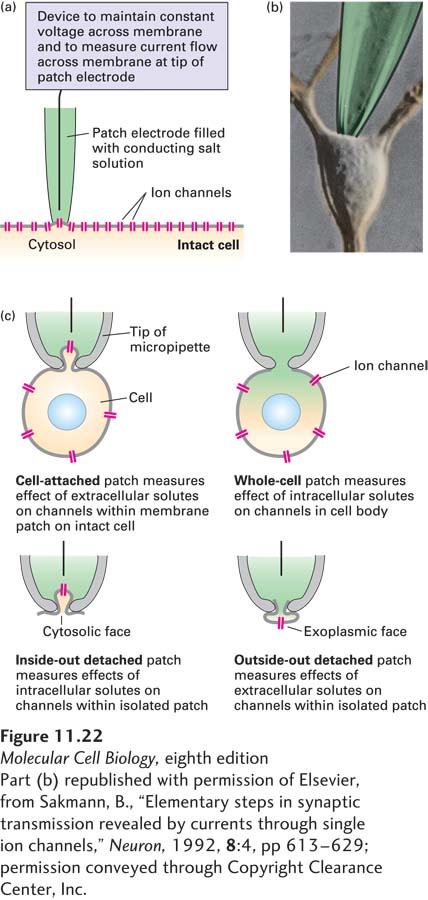
EXPERIMENTAL FIGURE 11- 22 Current flow through individual ion channels can be measured by patch clamping. (a) Basic experimental arrangement for measuring current flow through individual ion channels in the plasma membrane of a live cell. The patch electrode, filled with a current- conducting saline solution, is applied, with a slight suction, to the plasma membrane. The 0.5- µm- diameter tip covers a region that contains only one or a few ion channels. A recording device measures current flow only through the channel or channels in that region. (b) Photomicrograph of the cell body of a cultured neuron and the tip of a patch pipette touching the plasma membrane. (c) Different patch- clamping configurations. 1 In cell- attached patches, the electrode forms a tight seal around a patch of membrane; it records the effects on channels within this patch of different concentrations of ions and solutes such as extracellular hormones. 2 In whole- cell patch- clamp recording, suction is used to create a hole in the membrane so that the micropipette gains access to the inside of the cell. Reagents can be delivered to the cytoplasm through the micropipette, and their effects on channels in the entire cell body can be recorded. One can also study the effects of different reagents on channels in isolated, detached patches; these are the best configurations for studying the effects on channels of different ion concentrations. 3 In inside- out patches, one can measure the effect of intracellular reagents on channel function by exposing the tip of the micropipette to solutions containing defined reagents. 4 Outside- out patches are made from a whole- cell patch configuration by pulling the pipette away from the cell to create a bleb of membrane such that the exoplasmic face of the membrane has access to the solutions to which the tip of the micropipette is exposed. In this way, one can measure the effect of extracellular reagents on channel function. An inside- out patch, in which a cell- attached patch is formed and then the cell pulled away, is used in the experiment in Figure 11- 24 .
[Part (b) republished with permission of Elsevier, from Sakmann, B., “Elementary steps in synaptic transmission revealed by currents through single ion channels,” Neuron, 1992, 8:4, pp 613– 629; permission conveyed through Copyright Clearance Center, Inc.]
[Leave] [Close]